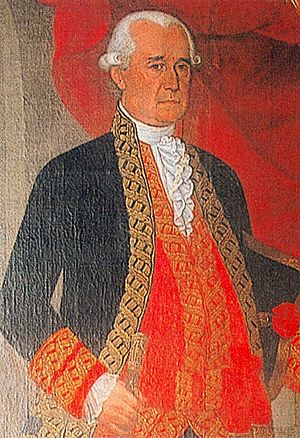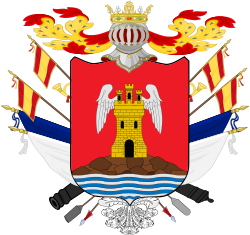Gabriel de Avilés, 4th Marquis of Avilés facts for kids
Quick facts for kids
Don
Gabriel de Avilés
Marquis of Avilés
|
|
|---|---|
 |
|
| 37th Viceroy of Peru | |
| In office November 5, 1801 – August 20, 1806 |
|
| Monarch | Charles IV |
| Prime Minister | Manuel de Godoy |
| Preceded by | Manuel Arredondo |
| Succeeded by | José de Abascal |
| Viceroy of Río de la Plata | |
| In office March 14, 1799 – May 20, 1801 |
|
| Monarch | Charles IV |
| Prime Minister | Count of Floridablanca |
| Preceded by | Antonio Olaguer Feliú |
| Succeeded by | Joaquín del Pino |
| Royal Governor of Chile | |
| In office September 18, 1796 – January 21, 1799 |
|
| Monarch | Charles IV |
| Prime Minister | Count of Floridablanca |
| Preceded by | José de Rezabal |
| Succeeded by | Joaquín del Pino |
| Personal details | |
| Born | c. 1735 Vic, Spain |
| Died | September 19, 1810 (aged 74–75) Valparaíso, Chile |
| Spouse | Mercedes del Risco |
| Profession | Lieutenant General |
Gabriel de Avilés Itúrbide y del Fierro, 4th Marquis of Avilés (born around 1735 – died September 19, 1810) was an important Spanish military officer. He also served as a colonial administrator in the Americas. He held powerful positions like governor of Chile and viceroy of both Río de la Plata and Peru.
Contents
Early Life and Career
Gabriel de Avilés was born in Vic, a city in Spain. His father was a high-ranking official. Gabriel joined the military when he was young.
In 1768, he was sent to Chile to teach cavalry skills. After two years, he moved to Peru. There, he became a sub-inspector general in the army. He married Mercedes del Risco y Ciudad, a Peruvian woman. She was known for her kindness and was called la santa virreina (the holy vicereine).
Role in Peru's Rebellion
In 1780, a major rebellion against Spanish rule began in Peru. It was led by Túpac Amaru II. The rebels had some early wins. People worried the uprising would spread across the entire region.
Avilés, who was a colonel at the time, was sent to defend the city of Cusco. His troops arrived just before the rebels started to surround the city. The rebel army was very large, with about 60,000 men. The Spanish forces faced a tough challenge. They worried about the rebels outside and possible uprisings inside the city.
However, the Spanish defense was successful. Túpac Amaru had to stop his attack and retreat. The Spanish viceroy sent a large force to chase him. Túpac Amaru was defeated, captured, and later executed with his family.
For his part in stopping the rebellion, Avilés was promoted in 1785. He became a brigadier and was made governor of Callao, a port city in Peru. He stayed in Peru until 1795. Then, he was promoted again to lieutenant general and sent back to Chile as its new governor.
Governor of Chile
Avilés became the governor of Chile in September 1795. He took over from Ambrosio O'Higgins.
In Santiago, the capital, Avilés worked to improve the city. He rebuilt the Hospital San Juan de Dios. He also reopened an old college as a shelter for poor people. He worked with the city council to fix bridges over the Mapocho River. They also paved streets and made the city cleaner and safer. Santiago got its first public lighting during his time.
Governor Avilés traveled around the colony. He ordered the building of churches and other public works in many places. He also supported projects to boost linen production. He helped establish the Academy of San Luis in 1797. This academy was important for education.
During his term, a special court called the Tribunal del Consulado was created. This court helped settle business and trade disagreements. Avilés served as governor until October 1796. He was then sent to Buenos Aires to become the viceroy of Río de la Plata.

Viceroy of Río de la Plata and Peru
Gabriel de Avilés served as viceroy in Buenos Aires until 1801. After that, he was promoted to the highest position: viceroy of Peru.
He took over as viceroy of Peru in 1801. He finished his term in 1806. After leaving office, he stayed in Lima for a few years. In 1810, he started a journey back to Spain. However, he became very ill. He had to stop in Valparaíso, where he passed away on September 19, 1810.
Gabriel de Avilés was known as a good person. He was kind and respected by many.
See also
 In Spanish: Gabriel de Avilés y del Fierro para niños
In Spanish: Gabriel de Avilés y del Fierro para niños

